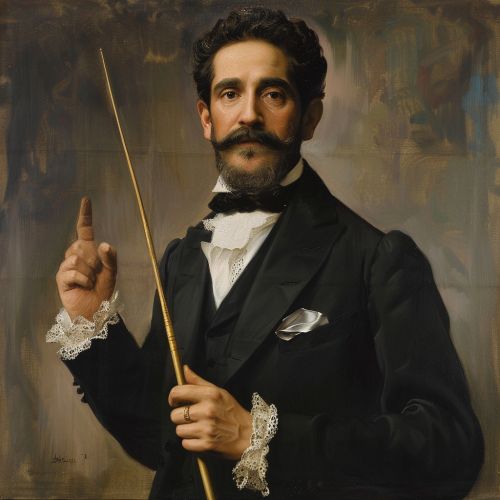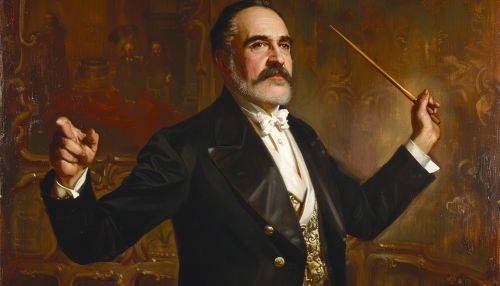Johann Strauss II
Early Life and Family Background
Johann Strauss II, also known as Johann Strauss Jr. or the "Waltz King," was born on October 25, 1825, in Vienna, Austria. He was the eldest son of the renowned composer Johann Strauss I and Maria Anna Streim. The Strauss family was deeply embedded in the musical culture of Vienna, with Johann Strauss I being a prominent composer and conductor of dance music. Despite his father's initial opposition to his musical ambitions, Johann Strauss II pursued a career in music, demonstrating prodigious talent from an early age.
Musical Education and Early Career
Strauss received his early musical education from private tutors, including violin lessons from Franz Amon, a member of his father's orchestra. He also studied music theory and composition under the guidance of Joseph Drechsler and later with the renowned composer and conductor Anton Kollmann. Strauss's early compositions were influenced by the works of his father and other contemporary composers such as Joseph Lanner.
In 1844, at the age of 19, Strauss formed his own orchestra and made his public debut at the Dommayer's Casino in Hietzing, a suburb of Vienna. His performance was a resounding success, and he quickly gained a reputation as a talented composer and conductor. Despite the rivalry with his father, Strauss's early works, including waltzes, polkas, and quadrilles, were well-received by the Viennese public.
Rise to Prominence
Following the death of his father in 1849, Johann Strauss II merged his orchestra with his father's ensemble, becoming the leading figure in Viennese dance music. His compositions during this period, such as the "Annen-Polka" (1852) and the "Kaiser-Walzer" (1889), showcased his mastery of the waltz form and solidified his reputation as the "Waltz King."
Strauss's music was characterized by its lyrical melodies, rich harmonies, and innovative orchestration. He expanded the traditional waltz form, incorporating elements of opera and symphonic music, which elevated the genre to new artistic heights. His works were performed in prestigious venues across Europe, including the Vienna State Opera and the Royal Opera House in London.
Major Works and Contributions
Johann Strauss II's oeuvre includes over 500 compositions, encompassing waltzes, polkas, marches, and operettas. Some of his most famous waltzes include "The Blue Danube" (1867), "Tales from the Vienna Woods" (1868), and "Wine, Women and Song" (1869). "The Blue Danube," in particular, became an unofficial anthem of Austria and remains one of the most recognizable pieces of classical music worldwide.
In addition to his dance music, Strauss made significant contributions to the genre of operetta. His operettas, such as "Die Fledermaus" (1874) and "The Gypsy Baron" (1885), combined elements of comic opera and musical theater, featuring lively melodies, humorous plots, and sophisticated orchestration. These works enjoyed immense popularity and were instrumental in shaping the development of Viennese operetta.
Influence and Legacy
Johann Strauss II's influence on the world of music extends beyond his lifetime. His innovative approach to dance music and operetta inspired subsequent generations of composers, including Gustav Mahler and Richard Strauss (no relation). His works continue to be performed and recorded by orchestras and ensembles around the globe, and his legacy as the "Waltz King" endures.
Strauss's music also played a significant role in popularizing Viennese culture and the Viennese waltz, contributing to the city's reputation as a center of musical excellence. His compositions remain a staple of concert repertoires and are frequently featured in events such as the Vienna New Year's Concert.
Personal Life and Relationships
Johann Strauss II's personal life was marked by a series of tumultuous relationships and marriages. He married his first wife, singer Henrietta Treffz, in 1862. Following her death in 1878, Strauss married actress Angelika Dittrich, a union that ended in divorce. His third marriage to Adele Deutsch in 1887 proved to be more stable, and she remained his companion until his death.
Despite his personal challenges, Strauss maintained close relationships with his family and colleagues. He collaborated with his brothers, Josef and Eduard Strauss, both of whom were accomplished musicians in their own right. The Strauss family's contributions to Viennese music were celebrated through numerous concerts and events, cementing their legacy in the annals of classical music.
Later Years and Death
In his later years, Johann Strauss II continued to compose and conduct, although his output slowed due to health issues. He remained an active figure in Vienna's musical scene, and his works continued to be celebrated by audiences and critics alike. Strauss passed away on June 3, 1899, in Vienna, leaving behind a rich legacy of musical innovation and excellence.
See Also


